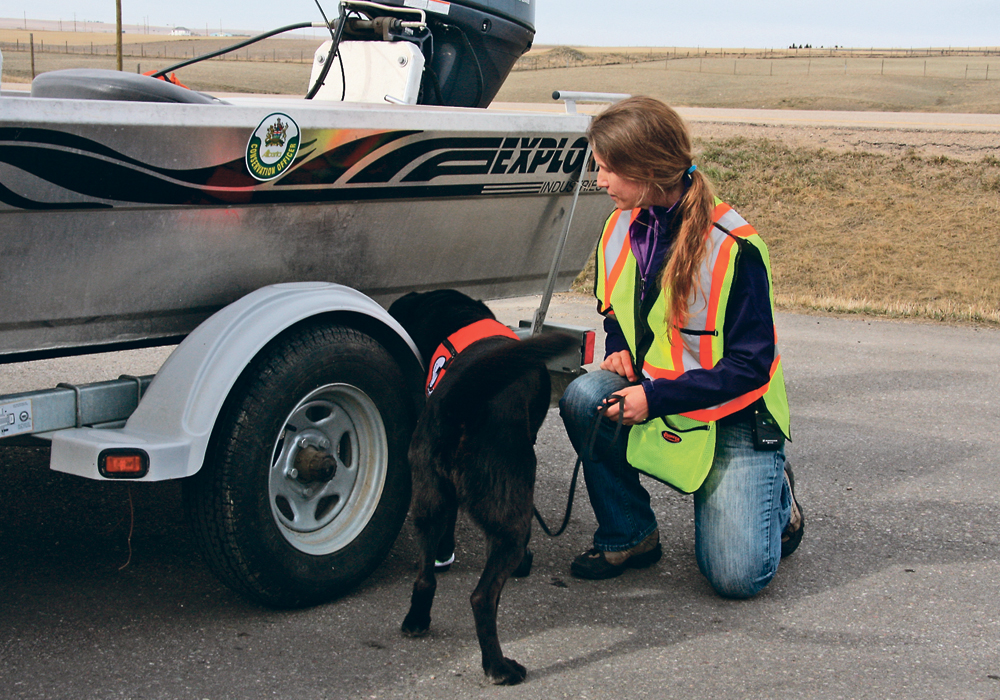Dogs initially had trouble finding the disease in undisturbed soil but were soon pulling out canola stubble to reveal galls
Dogs can be trained to find clubroot in canola fields.
The fact became obvious Sept. 17 when two dogs that were trained in clubroot detection were brought to Alberta to test their sniffing skills.
Michael Harding, crop pathologist with Alberta Agriculture, was on hand to see the test.
“They definitely had the capability of finding clubroot in a canola field,” he said.
Clubroot is a production limiting disease in canola that does its work below ground, creating galls on plant roots that affect production. It is impossible to confirm without pulling up plants and examining the roots.
Read Also

Farming Smarter receives financial boost from Alberta government for potato research
Farming Smarter near Lethbridge got a boost to its research equipment, thanks to the Alberta government’s increase in funding for research associations.
Now Harding’s project has confirmed dogs can detect its presence by using their superior olfactory capabilities.
Four dogs have been trained for the task by Bill Grimmer, an internationally respected dog handler based in New Brunswick who has also trained dogs for drug detection, police rescue and service to the disabled.
Two of those dogs, a German shepherd and a Labradoodle, were brought to Alberta and successfully detected clubroot 100 percent of the time in a clinical demonstration involving cups of soil and in finding a hidden canister bearing clubroot.
Out in a swathed canola field, Harding said the dogs were initially slow to identify clubroot under crusted, undisturbed soil, but once that was remedied they responded with positive identification of infested areas.
“As soon as the trainer started to reward the dogs for finding it on the canola plants under the ground, they started to make the connection,” said Harding.
Before long, the dogs were pulling canola stubble from the ground to show telltale galls on the roots.
That was surprising given the dogs had not been previously trained to do that, Harding said.
With the concept proven, it’s possible more dogs could be trained for the task.
“Let’s say you discovered clubroot in a field and you wanted to know if that was the only patch. You could take the dogs through and have them sniff out if there were other locations where there were significant clubroot symptoms,” said Harding.
He noted some counties try to scout every canola field within their boundaries in hopes of containing the destructive crop disease. It’s a time-consuming task.
“Having the dog is a way to non-destructively scout in a confined area. That dog can’t run the whole 160-acre field, but let’s say there was 100 sq. feet or even 100 sq. metres that you wanted to scout. The dog could do that quite quickly without having to pull up roots. The dog could alert you to where the symptoms were and then you could confirm it.”
Surveillance is key because soil-borne clubroot has a firm foothold in Alberta fields surrounding Edmonton and is gradually spreading outward. Less severe infestations have also been found in Saskatchewan and Manitoba.
The proof-of-concept dog project was funded by Farming Smarter, the southern Alberta applied research group, using $35,000 obtained through the Canadian Agricultural Partnership.
Harding said he will now write a final report and see where it goes from there. Greater use of dogs in this capacity would require more trainers, more dogs and municipalities, agriculture groups or individuals willing to buy, use and care for the canines.
The trained Labradoodle that visited Alberta earlier this month was a rescue dog, Harding said.
“It was a very high energy dog, which is what the trainers look for. They don’t want lazy dogs. They want hard-working high-energy dogs. But apparently whoever had the dog couldn’t deal with it and so it was scheduled to be euthanized.
“It went from being scheduled for euthanization to being an actual working dog.”


















